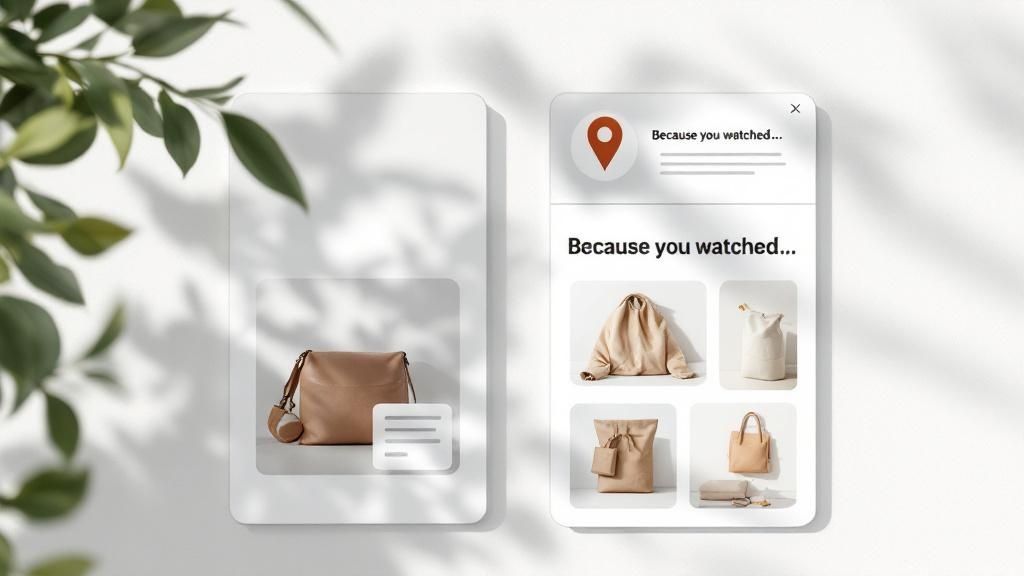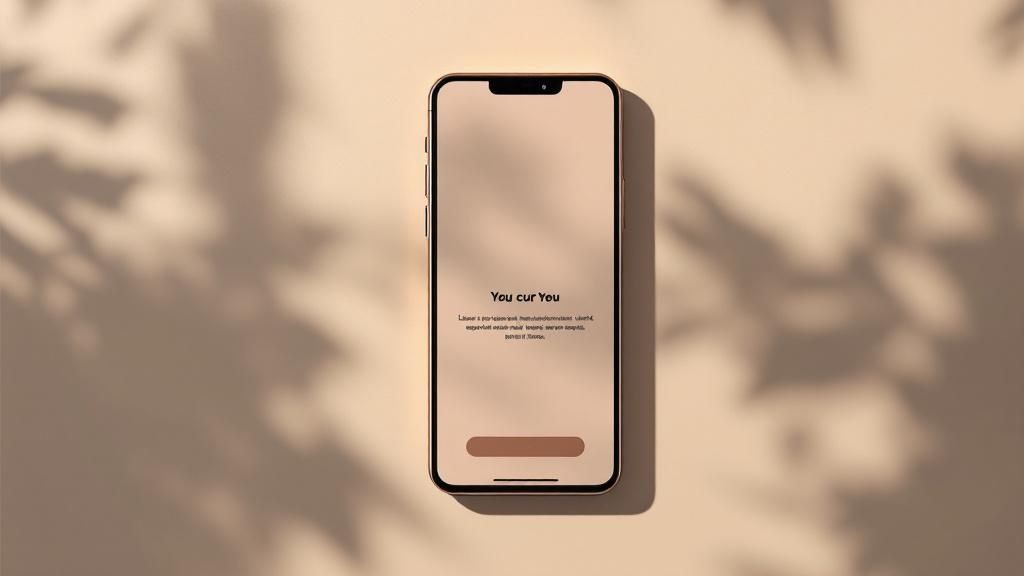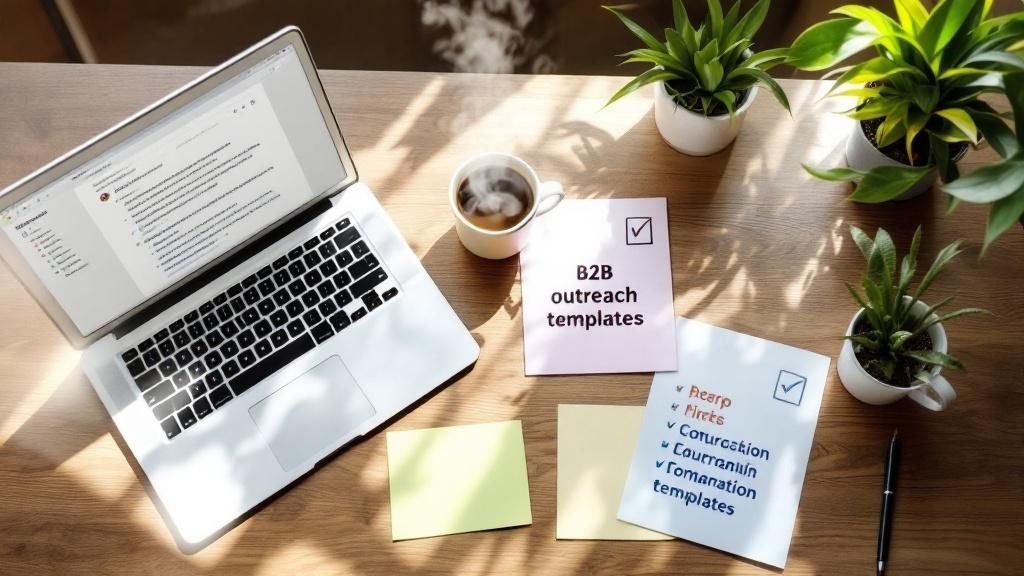Unlocking the Inbox: Your Guide to Higher Email Open Rates
Want to improve email open rates and boost your B2B outreach success? You're in the right place. This in-depth guide provides eight actionable tactics to help your emails stand out in crowded inboxes. We'll explore proven strategies to capture your audience's attention and drive engagement, from optimizing subject lines and sender information to mastering email deliverability.
Low open rates often signal issues with deliverability, targeting, or messaging. Improving them is crucial for maximizing your campaign ROI and connecting with your target audience. These strategies work for solo sales professionals, marketing agencies, and large enterprise teams alike. Whether you're sending newsletters, promotional offers, or personalized sales emails, understanding these techniques will significantly impact your results. This guide skips the fluff and gets straight to the practical advice you need to improve email open rates in 2025.
This listicle will cover these key areas:
- Subject Line Optimization: Craft compelling subject lines that grab attention.
- Sender Details: Optimize your sender name and email address to build trust.
- List Segmentation: Target specific audience segments for higher relevance.
- Timing and Frequency: Send emails when your audience is most likely to engage.
- Personalization: Tailor email content for a more engaging experience.
- Mobile Optimization: Ensure emails render perfectly on all devices.
- Preview Text: Maximize the impact of preview text to entice opens.
- Email Authentication: Enhance deliverability and avoid spam filters.
Ready to transform your email outreach? Let's dive in.
1. Subject Line Optimization
Subject line optimization is the cornerstone of improving email open rates. It's the art and science of crafting compelling subject lines that grab attention and entice recipients to open your emails. Think of it as your one shot to make a first impression – a poorly crafted subject line often leads to your email being ignored, regardless of how valuable the content inside might be. For B2B outreach, where inboxes are overflowing, a strong subject line is paramount.

This optimization involves leveraging psychological triggers, personalization, and a touch of urgency or curiosity. It's about understanding your audience and what resonates with them. Testing different approaches is also crucial to identify what works best for your specific target demographic. A/B testing subject lines allows you to gather data and continuously refine your approach.
Examples of Effective Subject Lines
- Netflix: "Your next binge-watch is here" (curiosity + personalization)
- Airbnb: "You have messages from 3 hosts" (urgency + specific numbers)
- Spotify: "Your 2023 Wrapped is ready" (personalization + FOMO)
- Amazon: "Your order has shipped" (transactional + immediate relevance)
These examples demonstrate the power of combining different elements. Notice the use of personalization, numbers, and a clear understanding of the recipient's interests.
Actionable Tips for Subject Line Optimization
- Use Numbers and Specific Details: Quantifiable information immediately draws the eye and adds credibility. Instead of "Increase your sales," try "3 Proven Strategies to Boost Sales by 20%."
- Create Urgency (Subtly): A sense of urgency can encourage immediate action, but avoid being pushy. "Early Bird Discount Ends Tonight" is more effective than "DON'T MISS OUT!!!"
- Test Emojis (Strategically): Emojis can add personality and help your email stand out, but test them with your target audience as responses vary.
- Optimize for Mobile: Many emails are opened on mobile devices, so keep subject lines short and concise (under 50 characters is ideal). Preview text is also essential – use it as an extension of your subject line to provide further context.
- Avoid ALL CAPS and Excessive Punctuation: These practices often trigger spam filters and appear unprofessional.
Subject line optimization is essential for any B2B outreach team looking to improve email open rates. It’s the first step in a successful email marketing campaign. By understanding your audience, employing these tips, and consistently testing different approaches, you can dramatically increase your chances of getting your emails read and ultimately achieve your business objectives. By crafting compelling subject lines that speak directly to the recipient's needs and interests, you can cut through the inbox clutter and drive engagement. Don’t underestimate the power of a well-crafted subject line – it's the gateway to your email's success.
2. Sender Name and Email Address Optimization
Sender name and email address optimization is a crucial yet often overlooked aspect of improving email open rates. It's about strategically choosing the "from" name and email address to build trust, recognition, and authority with recipients. This involves striking a balance between creating a personal connection and maintaining brand recognition. For B2B outreach, where establishing credibility is paramount, ensuring the sender identity aligns with recipient expectations and the relationship context is essential.
This optimization goes beyond simply using your company name. It involves considering how your audience perceives different sender identities and tailoring your approach accordingly. A poorly chosen sender name can lead to your email being dismissed as spam or simply ignored, while a well-optimized one can significantly boost your open rates. It’s about signaling trustworthiness and relevance from the moment the email lands in the inbox.
Examples of Effective Sender Names
- HubSpot: "Dharmesh from HubSpot" (personal + brand)
- Morning Brew: "Austin from Morning Brew" (consistent personal brand)
- Basecamp: "Jason from Basecamp" (founder-led communication)
- ConvertKit: "Nathan Barry" (CEO direct communication)
These examples demonstrate the effectiveness of combining personal names with brand recognition. This approach creates a sense of personal connection while maintaining the authority of the brand.
Actionable Tips for Sender Name and Email Address Optimization
- Use Real Person Names When Possible: A name like "John from Sales" feels more personal and approachable than "Sales Team." This humanizes your communication and can increase engagement.
- Keep Sender Name Consistent Across Campaigns: Consistency builds familiarity and recognition. Recipients are more likely to open emails from a sender they recognize.
- Match Sender Identity to Email Content and Purpose: The sender name should align with the email's content. A marketing email might come from "Marketing Team," while a personal outreach email could come from an individual sales representative.
- Test Personal vs. Company Name for Your Audience: A/B test different sender names to see what resonates best with your target audience. Data-driven insights are crucial for optimizing this element.
- Ensure Sender Name Appears Fully on Mobile Devices: Many emails are opened on mobile, so optimize the sender name to be fully visible on smaller screens.
- Use a Recognizable Company Domain: Avoid using generic email addresses. A professional domain builds trust and reinforces your brand identity.
Sender name and email address optimization is a fundamental element of successful B2B outreach. By crafting a sender identity that resonates with your audience and builds trust, you can significantly improve your email open rates and drive better engagement. It's a simple yet powerful way to make a positive first impression and encourage recipients to open your emails. Don’t underestimate the impact of a well-chosen sender name – it sets the stage for all subsequent communication.
3. Email List Segmentation
Email list segmentation is the practice of dividing your email list into smaller, more targeted groups. This division is based on specific criteria such as demographics, behavior, preferences, or engagement history. By tailoring your message to specific segments, you avoid sending generic emails that might be irrelevant to a large portion of your audience. This targeted approach leads to higher open rates, click-through rates, and overall engagement, which is particularly valuable in B2B outreach where relevance is key.

The infographic above visualizes the benefits of different segmentation strategies. As you can see, segmenting your audience based on behavior, demographics, and engagement can significantly improve key metrics like open rates, click-through rates, and unsubscribe rates.
Examples of Effective Segmentation
- Spotify: Segments by music genre preferences and listening habits, delivering personalized playlists and recommendations.
- Amazon: Segments by purchase history and browsing behavior, recommending relevant products and deals.
- Sephora: Segments by beauty profile, skin type, and purchase frequency, tailoring product promotions and beauty tips.
- LinkedIn: Segments by job title, industry, and platform activity, providing customized job recommendations and industry news. These examples illustrate how segmentation allows businesses to deliver the right message to the right audience at the right time.
Actionable Tips for List Segmentation
- Start Simple: Begin with basic segments (e.g., industry, job title) and gradually increase complexity as you gather more data.
- Progressive Profiling: Use forms and surveys to gather additional data over time, enriching your customer profiles and enabling more precise targeting.
- Hyper-Targeting: Combine multiple segmentation criteria (e.g., industry + job title + engagement level) for highly personalized messaging.
- Regular Audits: Regularly clean and update your segments to ensure accuracy and relevance. Remove inactive subscribers and update information as needed.
- A/B Test: Test segment-specific content against generic content to measure the impact of segmentation on your key metrics. This data-driven approach ensures you're delivering the most effective message to each segment.
- Automation: Use marketing automation tools to dynamically update segments based on real-time behavior and engagement, ensuring your segments remain relevant and up-to-date. This dynamic segmentation allows for timely and personalized communication.
For B2B outreach teams, effective email list segmentation is a critical factor in improving open rates. Learn more about Email List Segmentation. By delivering relevant and targeted content, you demonstrate a deep understanding of your audience's needs, fostering trust and credibility, ultimately leading to increased engagement and stronger business relationships. Don't underestimate the power of segmentation – it's a fundamental step in maximizing the effectiveness of your email marketing efforts.
4. Email Timing and Frequency Optimization
Email timing and frequency optimization is the strategic approach to determining the optimal times, days, and frequency for sending emails to maximize open rates and engagement. It's about understanding when your target audience is most likely to be receptive to your message, increasing the chances your email will be seen and opened amidst the daily influx of messages. For B2B outreach, this means analyzing recipient behavior patterns, time zones, and even industry-specific trends. Successfully implementing this strategy helps minimize unsubscribes and prevents email fatigue, fostering stronger relationships with your audience.
This optimization goes beyond simply guessing the best send time. It involves data analysis and a willingness to experiment. Learn more about email timing and frequency optimization. A well-timed email can significantly improve open rates, ultimately impacting the effectiveness of your overall B2B outreach strategy.
Examples of Effective Timing and Frequency
- Morning Brew: Sends its daily newsletter at 6 AM EST, capitalizing on the morning routine of many readers.
- TheSkimm: Delivers its daily digest before 8 AM, targeting subscribers during their commute or before their workday begins.
- Retail Brands: Often send promotional emails Tuesday-Thursday between 10 AM and 2 PM, aligning with peak online shopping activity.
- B2B Companies: Typically see better results sending emails Tuesday-Thursday between 9 AM and 11 AM, when professionals are often settling into their workday.
These examples highlight the importance of aligning your send times with your target audience's habits.
Actionable Tips for Email Timing and Frequency Optimization
- Test Different Send Times: Use A/B split testing to identify the optimal send times for your specific audience.
- Consider Your Audience's Lifestyle: Think about their typical workday, time zone, and when they're most likely to check their email.
- Use Send Time Optimization Features: Many email marketing platforms offer automated send time optimization tools. Leverage these tools to streamline the process. To effectively segment your email list, consider leveraging tools that integrate with your email marketing platform, and here is an article about Email Marketing Integrations.
- Monitor Engagement Patterns: Don't focus solely on open rates. Track clicks, conversions, and replies to gauge true engagement.
- Adjust Frequency Based on Engagement: If engagement drops, consider reducing the frequency of your emails to avoid overwhelming your subscribers.
- Account for Holidays and Industry Events: Adjust your schedule around holidays and industry-specific busy periods to avoid getting lost in the noise.
Email timing and frequency optimization is crucial for B2B outreach. It’s about delivering the right message at the right time. By carefully analyzing your audience and continually testing and refining your approach, you can significantly improve your email open rates and overall campaign effectiveness. A well-timed email can be the difference between a successful campaign and one that falls flat.
5. Personalization and Dynamic Content
Personalization and dynamic content are powerful tools for improving email open rates. This approach leverages subscriber data to create customized email experiences that speak directly to individual recipients' interests, behaviors, and preferences. This goes beyond simply inserting a recipient's name; it involves tailoring the entire email content to resonate with their specific needs and context. For B2B outreach, where building relationships and demonstrating value are key, personalized emails can significantly boost engagement.

This method works by using data points like past purchases, browsing history, location, and engagement with previous emails to dynamically adjust the content displayed within the email. This ensures that each recipient receives an email that is uniquely relevant to them, increasing the likelihood of them opening and engaging with the message. Dynamic content can include product recommendations, personalized offers, location-based promotions, and industry-specific information.
Examples of Effective Personalization
- Netflix: "Because you watched…" personalized recommendations
- Amazon: Dynamic product recommendations based on browsing history
- Starbucks: Location-based store promotions and weather-triggered drink suggestions
- Spotify: Personalized playlists and music discovery emails
These examples demonstrate the versatility of personalization. They show how brands use data to tailor email content and offer a more engaging experience.
Actionable Tips for Personalization
- Start Simple: Begin with basic personalization (like name and company) and gradually increase the level of sophistication as you gather more data.
- Leverage Behavioral Data: Use behavioral data, such as website activity and email engagement, to trigger relevant content and offers.
- Have a Backup Plan: Implement fallback content for instances where you lack complete data for a recipient, ensuring a positive experience for everyone.
- Test and Refine: A/B test personalized emails against non-personalized versions to measure the impact on open rates and engagement.
- Prioritize Privacy: Be transparent about your data usage and respect recipient privacy preferences.
- Scale Effectively: Use dynamic content blocks within your email marketing platform to streamline the personalization process and make it scalable.
Personalization is a critical element for any B2B outreach team seeking to improve email open rates. It helps you break through the inbox clutter and connect with prospects on a more personal level. By delivering truly relevant and engaging emails, you can foster stronger relationships, establish credibility, and ultimately improve your email marketing results. Don't just send emails; send personalized experiences.
6. Mobile Optimization
Mobile optimization is crucial for improving email open rates. With over 60% of emails opened on mobile devices, neglecting this aspect can significantly impact your outreach success. It's the comprehensive approach to ensuring your emails are designed, formatted, and optimized specifically for viewing on smartphones and tablets. This encompasses responsive design, touch-friendly elements, fast loading times, and a seamless mobile user experience. Ignoring mobile optimization means potentially alienating a large portion of your audience.

This approach recognizes that mobile users interact with emails differently than desktop users. They're often on the go and have shorter attention spans. Therefore, emails need to be easily digestible, visually appealing, and quick to load. To further enhance personalization, explore the role of AI in marketing: künstliche intelligenz im marketing. This can offer a valuable advantage in tailoring your messaging to individual needs and preferences.
Examples of Effective Mobile Optimization
- Uber: Clean, single-column design with large, prominent CTA buttons.
- Airbnb: Image-heavy, responsive design that scales perfectly across different screen sizes.
- Apple: Minimalist design, specifically optimized for the iOS Mail app.
- Warby Parker: Touch-friendly product browsing experience within the email itself.
These brands demonstrate the power of prioritizing the mobile user experience. They understand the importance of clear visuals, easy navigation, and a streamlined design for mobile devices.
Actionable Tips for Mobile Optimization
- Use Single-Column Layouts: This ensures readability and avoids horizontal scrolling.
- Make Buttons at Least 44px Tall: This makes them easy to tap with a finger on a touchscreen.
- Keep Subject Lines Under 30 Characters: Optimize for mobile preview displays.
- Use Large, Readable Fonts (14px Minimum): Strain on the eyes discourages engagement.
- Optimize Images for Fast Loading: Mobile users are less tolerant of slow loading times.
- Test on Actual Devices: Don't rely solely on simulators; test on various real devices.
Mobile optimization is essential for any B2B outreach team looking to improve email open rates. By implementing these tips, you can create a positive mobile experience that encourages recipients to engage with your content. In today's mobile-first world, prioritizing mobile optimization is not just a best practice – it's a necessity for achieving your email marketing goals.
7. Preview Text Optimization
Preview text optimization, often overlooked, is a powerful tool for improving email open rates. This element, also known as preheader text, appears next to the subject line in most email clients. It offers a valuable opportunity to expand on your subject line, providing further context and enticing recipients to open the email. For B2B outreach, where grabbing attention is crucial, optimizing preview text can significantly improve engagement.
Think of preview text as a second subject line – a chance to reinforce your message and pique the reader’s curiosity. It allows you to highlight key benefits, create a sense of urgency, or personalize the email further. Crafting compelling preview text can be the difference between an unopened email and a successful conversion.
Examples of Effective Preview Text
- Grammarly: Subject: 'Your weekly writing update' Preview: 'See how your writing improved this week and get personalized tips'
- Headspace: Subject: 'Time to unwind?' Preview: 'Try tonight's sleep story: The Lighthouse Keeper'
- Patagonia: Subject: 'New arrivals for fall' Preview: 'Sustainable gear for your next adventure – shop the collection'
- Duolingo: Subject: 'Your streak is in jeopardy!' Preview: 'Don't break your 47-day streak – just 5 minutes needed'
These examples demonstrate how preview text complements the subject line. They offer additional details, creating a more compelling reason to open the email.
Actionable Tips for Preview Text Optimization
- Complement, Don't Repeat: Your preview text should add to your subject line, not simply restate it.
- Highlight Benefits: Clearly state the value proposition or benefit the recipient will gain by opening the email.
- Create Curiosity: Use intriguing language that encourages recipients to learn more.
- Be Concise: Preview text is often truncated, so keep it short and to the point, ideally under 100 characters.
- Test and Refine: Experiment with different preview text variations to see what resonates best with your audience.
- Avoid Default Text: Ensure your preview text isn’t pulling in generic email content like "View this email in your browser."
Preview text optimization is a simple yet highly effective tactic to improve email open rates in B2B outreach. By utilizing this valuable space strategically, you can significantly increase engagement and drive better results from your email campaigns. A well-crafted preview text, working in tandem with a strong subject line, provides a powerful one-two punch that compels recipients to open and engage with your message. Don't let this valuable real estate go to waste – optimize your preview text to maximize your open rates and achieve your business objectives.
8. Email Authentication and Deliverability
Email authentication and deliverability are foundational for improving email open rates. They ensure your emails actually reach recipients' inboxes instead of languishing in spam folders. Without proper authentication, your carefully crafted subject lines and valuable content become irrelevant, as the email never has a chance to be seen. For B2B outreach, this is especially critical, as a single misplaced email can mean a lost opportunity.
This involves implementing technical protocols like SPF, DKIM, and DMARC, which verify your sender identity and protect against spoofing. It also encompasses managing your sender reputation and adhering to email service provider requirements. A strong sender reputation signals trustworthiness to email providers, increasing the likelihood of inbox placement.
Examples of Successful Implementation
- Salesforce: Provides comprehensive authentication setup with dedicated IP pools for optimal deliverability.
- Mailchimp: Offers built-in authentication for users with automatic setup, simplifying the process.
- HubSpot: Emphasizes domain alignment and authentication best practices for improved sender reputation.
- Campaign Monitor: Features deliverability monitoring and reputation management tools to track and improve inbox placement.
These examples demonstrate how different platforms prioritize deliverability to ensure their users' emails reach their intended audience. This proactive approach is crucial for successful email marketing.
Actionable Tips for Improved Deliverability
- Set up SPF, DKIM, and DMARC: These three authentication protocols are essential for verifying your sender identity and preventing spoofing.
- Monitor Sender Reputation: Regularly check your sender score and address any issues that could impact deliverability.
- Maintain Clean Email Lists: Regularly clean your email lists to remove invalid or inactive addresses, improving your sending reputation.
- Warm Up New IP Addresses: Gradually increase sending volume from new IP addresses to establish a positive sending history.
- Monitor Bounce Rates and Spam Complaints: Track these metrics to identify potential deliverability problems and take corrective action.
- Use Reputable Email Service Providers: Choose providers with a strong track record of deliverability and robust infrastructure.
Learn more about Email Authentication and Deliverability
Email authentication and deliverability are not just technical details, but essential components of a successful email strategy. By implementing these tips and prioritizing inbox placement, you ensure your emails have the opportunity to be opened and read, maximizing the impact of your B2B outreach. A strong sender reputation is a valuable asset in today's crowded digital landscape. Invest in deliverability to ensure your message reaches its target audience.
8 Key Strategies Comparison for Email Open Rates
| Strategy | Implementation Complexity 🔄 | Resource Requirements ⚡ | Expected Outcomes 📊 | Ideal Use Cases 💡 | Key Advantages ⭐ |
|---|---|---|---|---|---|
| Subject Line Optimization | Low 🔄 | Low ⚡ | Increased open rates; measurable impact 📊 | All email campaigns needing higher open rates | Immediate impact; cost-effective; easy to test ⭐ |
| Sender Name and Email Address Optimization | Low to Medium 🔄 | Low ⚡ | Builds trust and improves deliverability 📊 | Brand and personal connection in emails | Builds trust; reduces spam complaints; simple ⭐ |
| Email List Segmentation | Medium to High 🔄 | Medium to High ⚡ | Higher relevance; improved engagement and retention 📊 | Targeted messaging at scale | Increases conversions; reduces unsubscribes ⭐ |
| Email Timing and Frequency Optimization | Medium 🔄 | Medium ⚡ | Better open rates; reduced email fatigue 📊 | Timing-dependent campaigns; global audiences | Maximizes visibility; reduces unsubscribes ⭐ |
| Personalization and Dynamic Content | High 🔄 | High ⚡ | Greater engagement; higher conversions 📊 | Advanced marketing requiring tailored experiences | Drives revenue; improves customer satisfaction ⭐ |
| Mobile Optimization | Medium 🔄 | Medium ⚡ | Better user experience on mobile; higher engagement 📊 | Emails viewed mostly on mobile devices | Improves engagement; future-proofs campaigns ⭐ |
| Preview Text Optimization | Low 🔄 | Low ⚡ | Improved open rates; complements subject lines 📊 | Any email aiming to stand out in inbox | Adds context; easy to implement; boosts opens ⭐ |
| Email Authentication and Deliverability | High 🔄 | Medium to High ⚡ | Higher inbox placement; protects brand reputation 📊 | All email senders needing reliability | Ensures inbox presence; prevents spoofing ⭐ |
Elevate Your Email Game: Putting it All Together with Salesloop
Improving email open rates is a multifaceted challenge, but one well worth tackling. Throughout this article, we've explored eight key strategies to help you achieve just that. From crafting compelling subject lines and optimizing your sender information to leveraging the power of personalization and ensuring impeccable deliverability, each tactic plays a crucial role in boosting your open rates and driving engagement. Mastering these techniques isn't just about vanity metrics; it's about connecting with your audience, building stronger relationships, and ultimately driving measurable business results.
Key Takeaways for Improved Open Rates
Let's recap the most important takeaways for improving email open rates:
-
Subject lines are your first impression: Invest time in crafting concise, intriguing subject lines that resonate with your target audience and create a sense of urgency or exclusivity.
-
Sender information matters: Establish trust and recognition by optimizing your sender name and email address. Ensure clarity and professionalism to avoid landing in the spam folder.
-
Segmentation is key: Targeted email lists are the foundation of effective outreach. Segment your audience based on demographics, behavior, and engagement levels to deliver relevant content that resonates.
-
Timing is everything: Optimize your send times and frequency by analyzing your audience's behavior and identifying the optimal windows for engagement.
-
Personalization drives connection: Go beyond simply including a recipient's name. Leverage dynamic content and personalized messaging to create a tailored experience that fosters connection.
-
Mobile optimization is crucial: The majority of emails are opened on mobile devices. Ensure your emails are responsive and display correctly on all screen sizes.
-
Preview text enhances your subject line: Utilize preview text to provide additional context and entice recipients to open your emails.
-
Deliverability ensures your message arrives: Implement robust email authentication practices to maintain a high sender reputation and avoid spam filters. To delve deeper into ensuring your emails reach the intended recipients, resources like the Top 10 Call Center Services from Cloud Move offer insights into various communication channels and their best practices, especially for important outreach.
Why Focus on Open Rates?
Why are these strategies so important? Because open rates are the gateway to all other email marketing metrics. Without opens, there are no clicks, no conversions, and ultimately, no ROI. By prioritizing these eight tactics, you're not just increasing opens; you're setting the stage for a successful email marketing campaign that drives tangible results.
Next Steps: Implement and Iterate
Now that you're armed with these powerful strategies, the next step is implementation. Start by focusing on one or two areas where you see the biggest opportunity for improvement. Test different approaches, track your results, and iterate based on what you learn. Remember, improving email open rates is an ongoing process of refinement and adaptation.
Ready to streamline your email outreach and put these best practices into action? Salesloop.io offers a powerful platform to automate and optimize your B2B outreach, boosting your open rates and driving measurable results. Start your free trial today and experience the future of B2B outreach.





